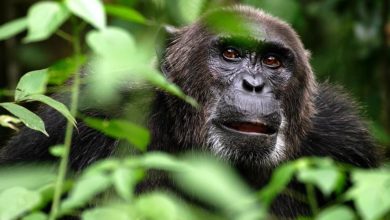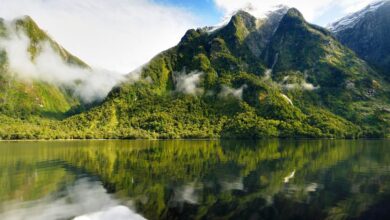Green sea turtle, Pacific green turtle (Chelonia mydas)
If you have watched Pixar’s Finding Nemo and remember Crush, you know the hero of the following article. A distinctive snout, colorful patterns on its carapace combined with slow, staid actions makes this animal very likable in human eyes. Let’s take a closer look at our Crush 🙂
Classification
- Kingdom: Animalia
- Class: Reptilia
- Order: Testudines
- Suborder: Cryptodira
- Family: Cheloniidae
- Genus: Chelonia
- Species: Chelonia mydas
- Names: Green sea turtle, Pacific green turtle, green turtle, black sea turtle
Subspecies:
- Chelonia mydas mydas
- Chelonia mydas agassizi
- Chelonia mydas japonica
- Chelonia mydas carringera

Distribution
It swims in the tropical and subtropical seas all over the world, its population can be divided into two main subgroups – the Atlantic subpopulation and the Indo-Pacific subpopulation. They are different in terms of genetics from one another, having separate nesting and feeding areas.
Atlantic subpopulation
In the entire Atlantic Ocean, the Chelonia mydas species may be found, there are reports of turtles swimming in the far north, near Canada (West Atlantic) and British Islands (East Atlantic). In the south, it may be observed from the southeast coasts of Africa all the way to Argentina.
The main nesting spots are located in the Caribbean, along the east coast of the United States, on the east coast of South America and above all, on isolated islands of the North Atlantic.
The main hatching spots in the Caribbean are Aves Island, United States Virgin Islands, Puerto Rico and Costa Rica. In recent years, there are signs of increasing numbers of hatching spots on the Cayman Islands. One of the most important hatching spots are the beaches of Tortuguero (Costa Rica) – it is the origin of the majority of the Caribbean population.
In United States waters, small breeding territories were recorded in Georgia, North Carolina, South Carolina and along Florida’s east coast. In the last region, most of the nests are located on Hutchinson Island South. In South America, the green sea turtle picked the calm beaches of Suriname and French Guyana. In the South Atlantic, the most popular breeding place is Ascension Island, boasting 6,000-15,000 nests.
Important feeding areas are located around Florida, including Indian River Lagoon, Florida Keys, Homosassa, Crystal River and Cedar Key.

Indo-Pacific subpopulation
It occupies the south coasts of Alaska up north, reaching Chile in the south. It extends up to north Japan and south parts of Russia in the West Pacific, also inhabiting the northern regions of New Zealand and several islands south of Tasmania. Furthermore, it lives in the whole Indian Ocean.
The nesting grounds are scattered all the way across the Pacific including Mexico, Hawaii, at Australian and Southeast Asian shores. The main breeding colonies are located e.g. in India, Pakistan and other coastal countries. There are also several nesting spots on the east coast of Africa, including the islands surrounding Madagascar.
They acquire food in the Gulf of California seagrass, while the Hawaiian population nests in the French Frigate Shoals atoll, about 800 km (497 mi) west of the Hawaiian Islands.
The green sea turtles from the Philippines nest on Galapagos Islands, with the closely related hawksbill sea turtles (Eretmochelys imbricata). In Indonesia, it lays eggs in the Meru Betiri National Park (East Java).
Reef areas are one of the most important hatching regions – the Great Barrier Reef is home to two genetically different populations of green sea turtles. In about 20 different places by the Reef, they lay eggs mostly on small islands such as Raine Island. The hatching spots are found on both sides of the Arabian Sea, on sandy beaches of Pakistan.

Habitats
The preferred habitat is highly dependent on the turtle’s life stage. The eggs are laid on beaches, while the adult turtles spend most of the time in shallow coastal waters abundant with seagrass. They love lagoons and bays, sometimes whole colonies migrate between the hatching and feeding areas.
The first 5 years of their lives are spent in the convergence zone (areas where two sea currents meet) in the open ocean. However, it rarely swims in deep waters, moreover, it is a rather slow animal – its speed oscillates around 2.5-3 km/h (1.5-1.8 mph)

Appearance
Its silhouette is typical for sea turtles: the carapace is slightly oblate, a streamline-shaped head is located on a short neck and the paddle-like front flippers are perfectly adapted to aid in swimming. Adult turtles measure around 1.5 m (5 ft), the mere carapace is 78-112 cm long (31-44 in), their weight ranging from 68 to 190 kg (150 to 419 lb), although truly giant turtles may reach even more than 315 kg (694 lb).
It may be distinguished from other members of its family by several features: contrary to the abovementioned hawksbill sea turtle, its snout is very short and its mouth is not hooked like a bird’s beak. The jaws have serrated edges and the mandible is stronger at has more ‘teeth’. The carapace consists of five main scutes (plates) and several side scutes. The plastron (ventral part of the carapace) consists of three main scutes and several side ones. The front flippers bear a single claw each (hawksbill sea turtles and immature green sea turtles have two on each flipper).
The carapace is very colorful and the color patterns transform as the turtle ages. The baby green sea turtles, like many other sea turtles, are black with white body edges. Immature carapaces are dark brown, red or olive, while the adult turtles are fully brown, spotted or ‘mosaic’, gaining a more motley appearance, while the plastron remains yellow.
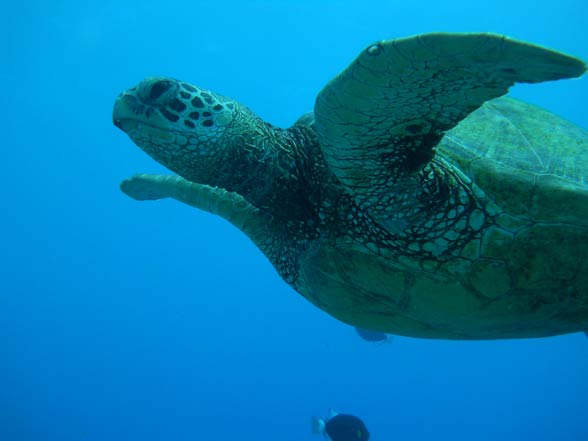
Diet
Contrary to most sea turtles, the green sea turtle is almost exclusively herbivorous, it eats seagrass and algae. Immature turtles often choose to eat invertebrates such as crabs, jellyfish, mussels or sponges.
Lifestyle
It migrates over large distances between feeding and hatching areas – some turtles travel up to 2600 km to their destination. Adult turtles often come back to the same beach they hatched on. Females make pairs with males every 2-4 years on average, while males visit mating regions every year trying to woo a partner. The hatching season depends on the population. Caribbean turtles lay their eggs between June and September, in French Guyana the season spreads between March and June while in the tropical areas green sea turtles may make nests all year long, although certain subpopulations prefer a given season of the year.
The hatching process is similar to other sea turtles – it is controlled by females. Several populations are polyandrous (a female copulates with many males), however, that does not affect the babies. The insemination takes place in water and then the eggs are laid on land – a female crawls out on a beach, digs a hole with its flippers and lays eggs in the pit. The size of a single hatch depends on the female age and subspecies, however, it may range from 100 – 200 eggs per hatch. At night, after 45 – 75 days, the babies are hatched and they instinctively head towards water.
The moment between hatching and getting into the ocean is a crucial step in the babies’ life, as the beaches are swarming with predators e.g. seagulls and crabs. As a result, a large part of the hatch never makes it to the ocean. Nonetheless, if they manage to succeed on this stage, they live in an open ocean for the next 3 – 5 years, before they settle down in shallow waters as adults.

Breathing and sleep
It spends its almost whole life in the water, yet it needs the atmospheric oxygen to breathe. A turtle may perform a gas exchange very quickly, which prevents thrombus at greater depths. During deep dives, its blood manages to transport the oxygen to organism cells even at large pressure.
It may rest and sleep underwater for several hours, however, this time shortens if it is occupied with eating or runs away from the predator. The ability to hold its breath depends on activeness and stress level, which is why a scared turtle is often easily caught in fishing nets.
Natural enemies
In the Hawaiian waters, it is hunted for by a tiger shark, yet the babies have much more enemies, including crabs, small marine mammals and aquatic birds. In Turkey, the eggs are often eaten by a red fox or a golden jackal. Withal, the largest threat for adult turtles are humans.
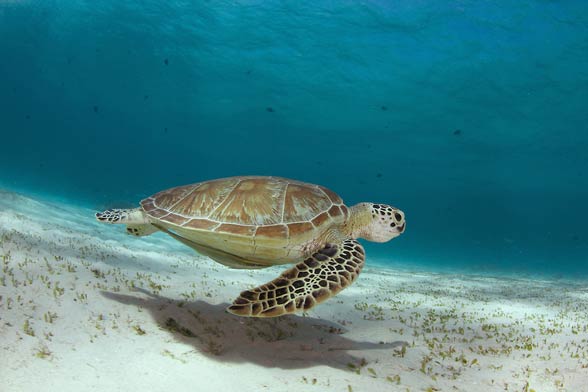
Green sea turtles and humans
In the past, the turtle skins were flamed and provided material for bags, mainly in Hawaii. In ancient China, the turtle’s meat was a delight known for its delicacy. In 19th century America a turtle soup from fat and cartilages was cooked, a very popular meal back in the day.
On Java, eggs were dainty, as Muslims consider its meat ‘impure’, not halal (Islam is the main religion on Java). It was treated entirely differently in Bali – its meat was one of the most important elements of religious ceremonies.
The green sea turtle was increasingly hunted for from the distant islands of the Indonesian archipelago. In the 50s, Bali became the main exporter and fished for turtles to such a degree, that they disappeared from the island. Today most Hindu Balinese people do not eat eggs, yet they sell them to local Muslims.
On the Cayman Islands, there was a farm specialized in selling turtles whole or only certain parts of their bodies (e.g. fat, skins, carapaces). However, such a business was only half-legal as the animals hatched from stolen eggs. At one point the farm had 100,000 turtles in its stock. Most of the market remains closed to such ‘goods’, so the farm began profiting from tourism. Today they have 11,000 turtles and change their name quite often. Since 2010, they are called Cayman Turtle Farm: Island Wildlife Encounter.
Sea turtles are inextricably woven into Cayman history and culture. When Columbus arrived at the islands in the 15th century, he called one island Las Tortugas in recognition of an astonishing number of sea turtles in coastal waters. Many settlers hunted for them for fresh meat.
The green sea turtle image is in the Cayman Islands coat of arms, which is also part of the country’s flag. Their currency also uses the green sea turtle as a watermark on the paper bills. The Cayman airlines have a green sea turtle mascot called Sir Turtle, its colors matching the national colors.
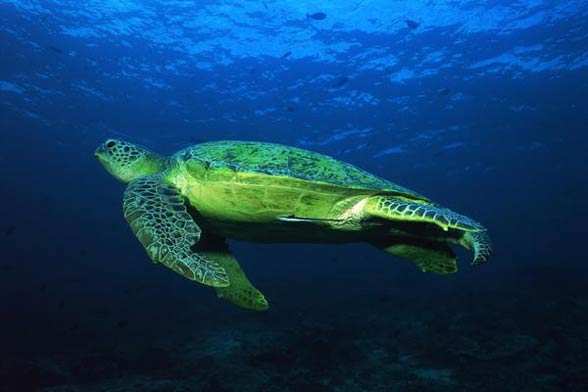
Detailed characteristic / size
Green sea turtle, Pacific green turtle (Chelonia mydas)
- Body length: about 1.5 m (5 ft)
- Carapace length: 78-112 cm (31-44 in), record – 153 cm (60 in)
- Weight: 68-190 kg (150-419 lb), exceptional over 300 kg (660 lb), record – 395 kg (871 lb)
- Lifespan: over 80 years

Green sea turtle – interesting facts
- The species name does not come from the body color, rather from the color of fat underneath the carapace.
- The largest known turtle weighed 395 kg and had a carapace 153 cm long (60 in).
- Every year on Ascension Island the females build 6,000-15,000 nests. This region spawns the largest specimen, measuring over 1 m (3.3 ft)and weighing about 300 kg (661 lb).
- A baby turtle spends 3-5 years in the open ocean before they adapt to shallower waters (still in their adolescence). This phenomenon suggests that they reach sexual maturity around 2-25 years of age.
- Contrary to most of its close relatives the green sea turtle crawls out on land not only in the hatching season, for example, the East Pacific turtles like to bask in the sun accompanied by albatrosses. It is an unusual example of a sea turtle leaving aquatic habitat beyond breeding season.
- The green sea turtle is an endangered species as it is still a target for poachers, which hunt for it for meat. In some regions, the turtle is critically endangered e.g. the Mediterranean subpopulation.











